
Dec'22
The IUP Journal of Entrepreneurship Development
Archives
Opportunities and Challenges of Tribal Entrepreneurship: A Review
Amar Vangad
Research Scholar, MGV's Institute of Management and Research, Nashik, Maharashtra, India; and is the corresponding author. E-mail: vangad.c.amar@gmail.com
Rajesh Kumar Pandey
Associate Professor, SSR Institute of Management and Research, Silvassa, Dadra and Nagar Haveli and Daman and Diu, India. E-mail: rajeshpandey18@gmail.com
The study examines 'Tribal Entrepreneurship' and the various opportunities and challenges that tribal entrepreneurs face. Selected research papers and articles on the theme were studied, based on which conceptual inferences were drawn for better clarity. Opportunities in terms of business avenues and government initiatives and schemes were collated. The major challenges identified for tribal entrepreneurship are lack of awareness, non-availability of resources, and lack of entrepreneurial abilities, social acceptance and encouragement. Based on these findings, 'Tribal Entrepreneurship Model' has been developed.
Introduction
Developing countries like India aim for a rapid, balanced, and sustainable economic growth. This growth can be attained only when the socioeconomic factors of a country are strengthened. One such key factor which has great potential to contribute to the society is entrepreneurship. It can be practiced by anyone irrespective of caste, community, or class. In India, many resources are abundant but entrepreneurship is scarce (Baporikar, 2009). Therefore, it should be encouraged to reap economic prosperity.
Entrepreneurship has evolved in various ways such as small business entrepreneurship, large business entrepreneurship, scalable startup entrepreneurship, social entrepreneurship, and innovative entrepreneurship (Types of Entrepreneurs, 2021). Now, rural entrepreneurship and tribal entrepreneurship have been coined to understand the entrepreneurial activity of these specific sections of the society. Irrespective of variations in entrepreneurship, it is fundamentally about developing, launching, and running an enterprise Wix Blog (2021). These variations are required to study the entrepreneurs in such realms.
Tribal entrepreneurship gained currency with the rise in the number of tribal entrepreneurs. In India, the tribal population constitutes 8.6% (Ministry of Tribal Affairs, 2022). 45.3% in rural areas and 24.1% in urban areas, totalling 69.4% of the population, are below poverty line (Ministry of Tribal Affairs, 2022). ST entrepreneurs account for only 4.10% (MSME Annual Report 2020-21). Therefore, it can be clearly inferred that largely the tribal population is either employment seekers or self-employed in petty economic activities.
It can also be drawn from the above that entrepreneurship is the area where the tribals need handholding for being self-reliant. The Government of India has taken many initiatives and one such initiative is by the Ministry of Tribal Affairs - 'Tribal Entrepreneurship Development Program (TEDP)' in association with ASSOCHAM's Center of Excellence. This program aims to enhance the potential and skills of tribal communities for their development and better living opportunities.
The research in this domain has the potential to contribute towards tribal entrepreneurship development. For instance, Vinamrta and Chakraborty (2020) advocated that self-employment is the proven way to reduce poverty and unemployment, achieve balanced economic growth and decentralization.
A few studies on tribal entrepreneurship are available. These studies attempt to understand the tribal entrepreneurship and its need. Early research has attempted to do so through both secondary and primary data and employing empirical as well as case-based research methodologies. It can be inferred from these studies that the entrepreneurial activity undertaken by a tribal can be classified under tribal entrepreneurship.
The study attempts to explore the concept of tribal entrepreneurship and identify the opportunities and challenges in this regard. Based on the existing research, precise understanding of tribal entrepreneurship is drawn and the tribal entrepreneurship model is developed. This study also discusses the opportunities and challenges reported in the available studies.
Objective
- To study the concept of tribal entrepreneurship.
- To identify the opportunities and challenges of tribal entrepreneurship.
Methodology
It is an exploratory research study and uses secondary data. The literature review was conducted using relevant research papers and articles. Based on the literature review, three sub-themes were identified (Figure 1):
- Tribal Entrepreneurship;
- Tribal Entrepreneurial Opportunities; and
- Tribal Entrepreneurial Challenges.
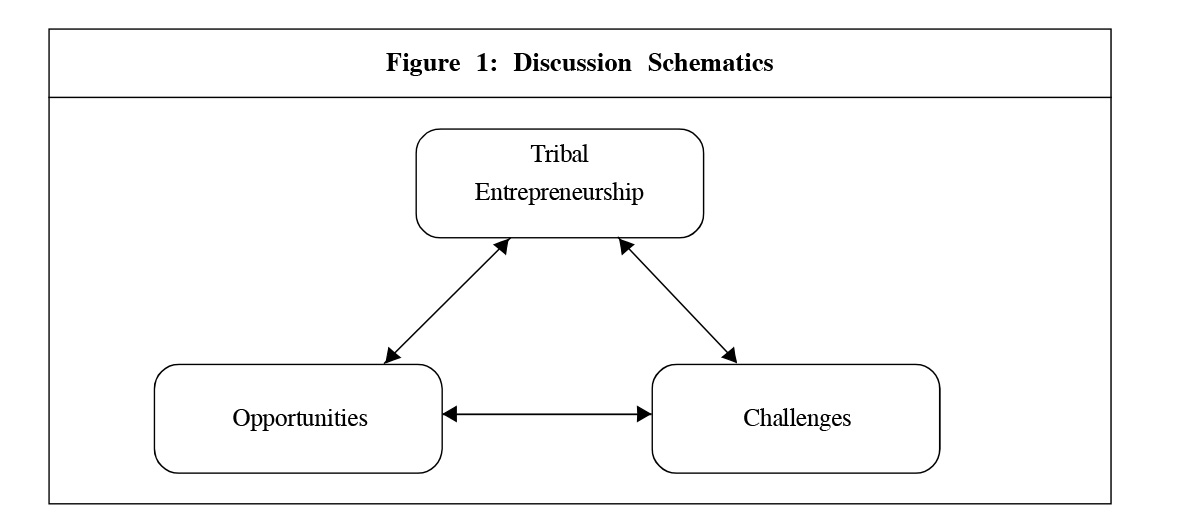
Tribal Entrepreneurship
The word 'tribe' has been derived from a Latin word 'tribus'. Tribus means 'the poor' (Yojana, 2022). Today, it is being used to refer to the aboriginal people. The Indian tribal communities predominantly have close association with nature, practice oral traditions and folk culture and are confined to their own commuting. Thus, tribals have been a self-reliant community. However, over the years, they have faced various challenges due to mainstream societal approach towards them and developmental activities that have led to deforestation and displacement of the tribal people. In contemporary India, tribals have been trying to integrate into the mainstream society. They have made their presence felt in education, sports, art, culture, business, etc., but they began late, and their socio-dynamics are different. Hence, today the tribals need special attention for inclusive development.
Entrepreneurship is one of the prominent areas that can bring back the self-reliant attribute of the tribals. Entrepreneurship is the process of starting, operating and managing a sustainable business. Therefore, such a process initiated by a tribal individual can be associated with the tribal entrepreneurship. Tribals are generally involved in three major occupational sectors: (i) agriculture; (ii) forestry; and (iii) handicrafts. However, with better awareness they have also got involved in various other businesses today.
Traditionally, entrepreneurship classification is based on fundamentals of starting a business and company operations itself (i.e., social or rural entrepreneurship). However, it also needs to be defined by the skills, characteristics, and personality traits of an entrepreneur. Tribal entrepreneurship has been studied earlier from both the perspectives. For instance, Pravesh (2016) defined tribal entrepreneurship as "the procedure of utilization of utility of traditional knowledge expertise by utilizing available, supportive resources, and infrastructure in new or different way to generate wealth, employment and welfare by tribal". This definition hints at the classification of tribal entrepreneurship based on fundamentals and operations of the business. Vinamrta and Chakraborty (2020), on the other hand, stated that tribal entrepreneurship is based on self-employment of the tribal individual or community irrespective of traditional knowledge or resources. This indicates the consideration of skills, characteristics, and personality traits. It should be noted that both Pravesh (2016) and Vinamrta and Chakraborty (2020) do not just advocate a single idea of tribal entrepreneurship. They write both the perspectives in conceptualizing the 'tribal entrepreneurship'.
Pravesh (2016) pointed out that major tribal entrepreneurship activity is associated with art, craft, painting, honey making, spices, medicines, agricultural produce including rice, maize, vegetables, spices, minor forest products and furniture made of bamboo and wood. Vinamrta and Chakraborty (2020) studied the tribal entrepreneurs involved in farm produce, contractor business, transportation business, construction business, cafe business, apparel business, tech-based businesses, and tribal business consultancy services.
Tribal Entrepreneurship Model
The features considered for tribal status in India are: (i) indications of primitive traits;
(ii) distinctive culture; (iii) geographical isolation; (iv) shyness of contact with the larger community; and (v) backwardness (Figure 2). The tribal community is constitutionally defined as Scheduled Tribes (ST). Thus, an entrepreneur belonging to this community is called an ST entrepreneur or a tribal entrepreneur.
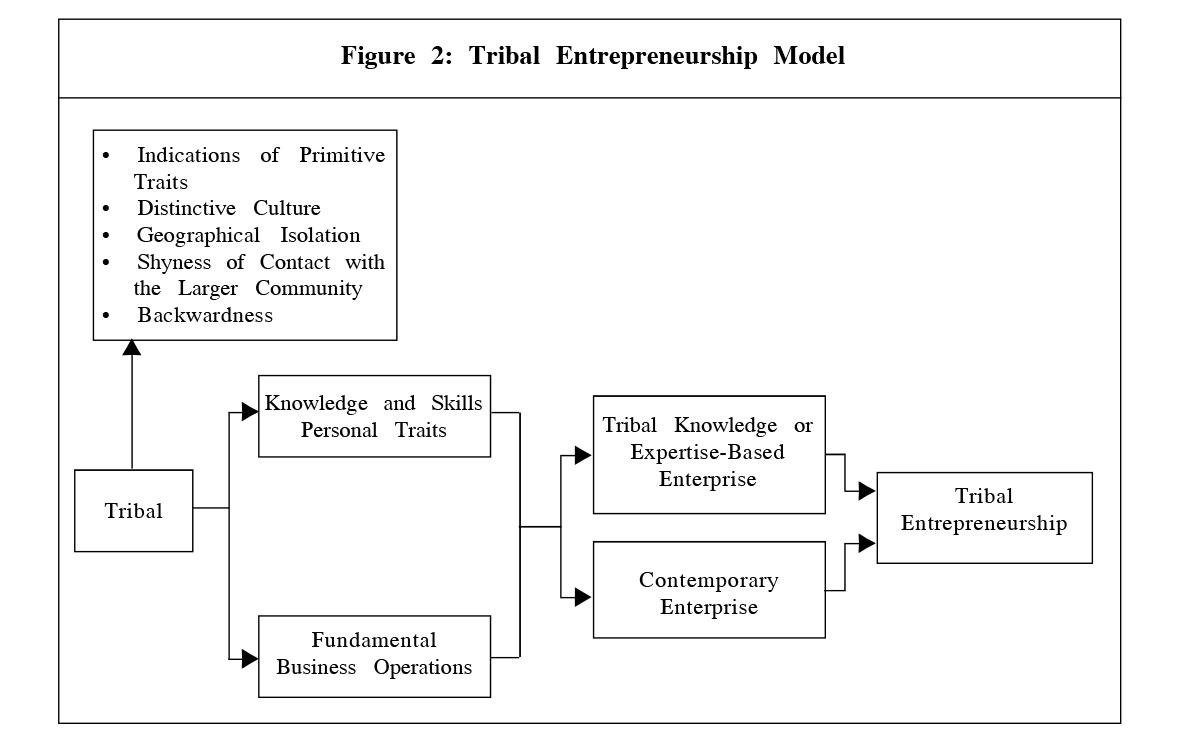
A tribal entrepreneur possesses his/her community characteristics. Due to the tribal characteristics, the personality traits are different from those of other class of entrepreneurs. For instance, a tribal entrepreneur may not be able to take higher risk, he may find it difficult to deal with other class vendors and customers and so on. Against these odds, the tribal entrepreneur has to start and run an enterprise.
Majorly, the enterprises started or run by the tribals are based on their traditional knowledge or expertise. It can be small farm produce or forestry produce dealing with art and craft, traditional apparel items, etc. However, with better awareness and education, they have been getting into contemporary enterprises also.
Therefore, tribal entrepreneurship involves starting and managing an enterprise by a tribal, applying his knowledge and skills, while leveraging the personal and societal influences that can be based on traditional knowledge and expertise or contemporary business.
Tribal Entrepreneurship: Opportunities
Tribal entrepreneurship have got ample opportunities. These opportunities are traditional tribal knowledge and expertise-based businesses, regular businesses, and governmental support in terms of various schemes and initiatives. For instance, Roy (2021) identified three main sectors for tribal entrepreneurship: (i) Agriculture; (ii) Forestry; and
(iii) Handicraft. Pravesh (2016) identified opportunities for tribal entrepreneurship in businesses involving herbal products, handicraft products, agriculture, tourism business, and mini forest product businesses. Similarly, Vinamrta and Chakraborty (2020) identified contractor business, transportation business, construction business, cafe business, apparel business, tech-based businesses, and tribal business consultancy services. Also, Sahu (2021) mentioned the opportunities in terms of policies and schemes for tribal entrepreneurship.
There have been a lot of initiatives from the government to encourage entrepreneurship in general. The Ministry of Micro, Small and Medium Enterprises (MSME) and the Ministry of Skill Development and Entrepreneurship (MSDE), State government departments and agencies, formal financial institutions, training and capacity development institutions, incubation centers are such initiatives. Table 1 lists the various government initiatives.
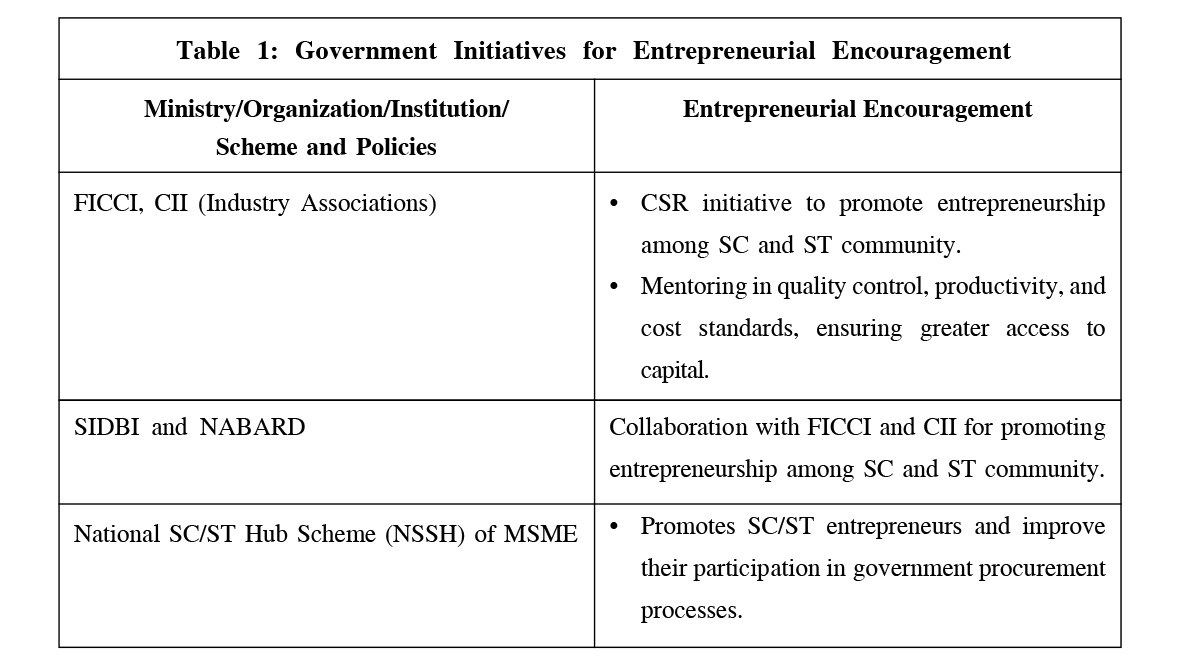
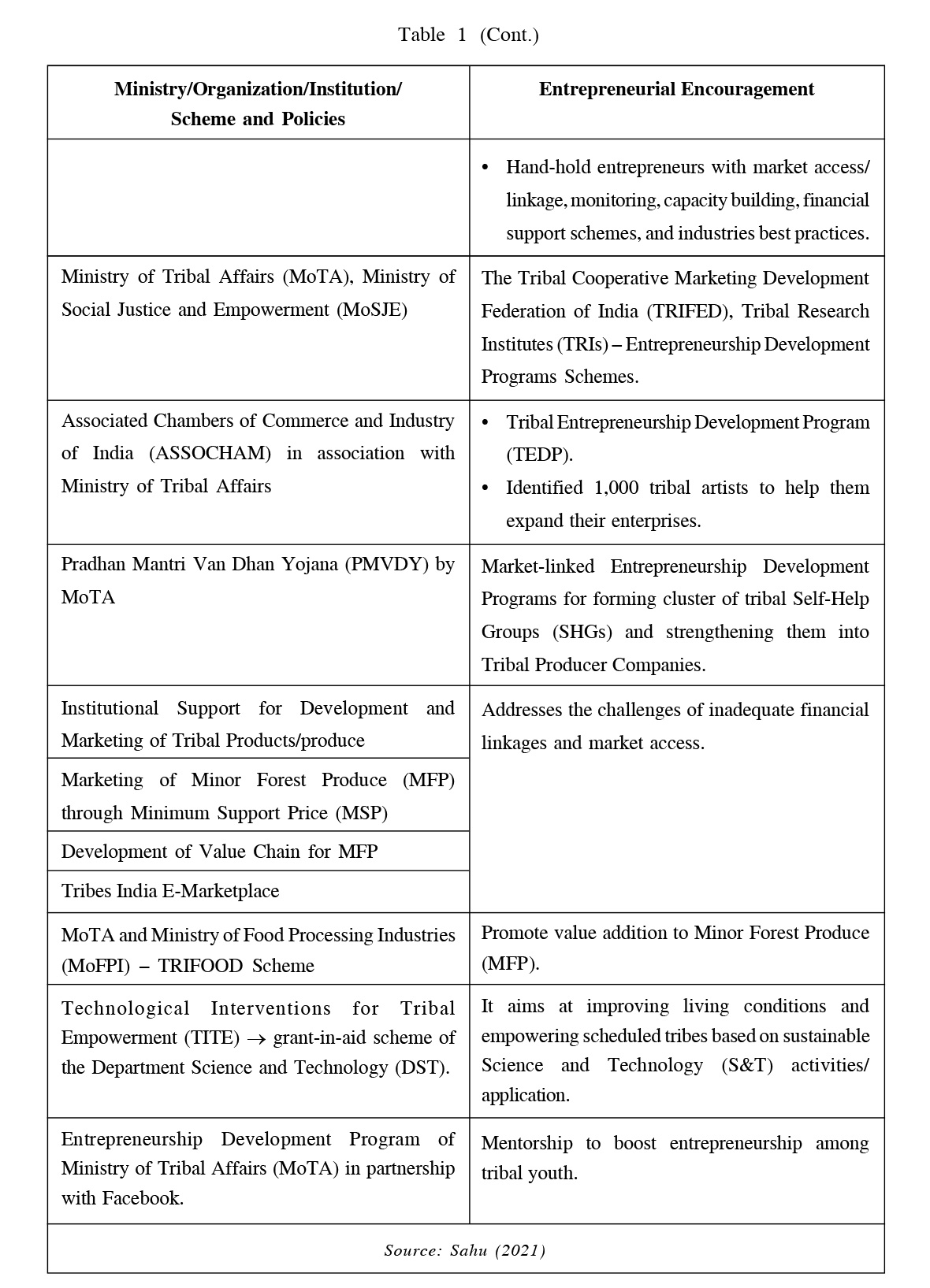
Tribal Entrepreneurship: Challenges
Vinamrta and Chakraborty (2020) stated that economic backwardness, mass poverty with low literacy, unemployment, inadequate infrastructural and administrative facilities lead to lower standard of living of the tribals, and these need to be addressed. They further stated that the challenges specific to the tribal entrepreneurship are: (a) need for motivation; (b) resources availability; (c) entrepreneur skills; and (d) social and political support system.
According to Pravesh (2016), the challenges for tribal entrepreneurship are financial constraints, policy changes, lack of infrastructure, low motivation, lack of functional expertise, inability to develop a strong business idea, and personal and miscellaneous business challenges. The financial challenges faced by the tribal entrepreneurs are (a) startup financing; (b) access to government fundings; and (c) mezzanine financing. They are not just deprived of capital for their business/business idea but are also either unaware of government funding or are unable to avail the same due to compliances and complexities. Many poor and less educated entrepreneurs find it difficult to cope with the policy changes. That tribal areas are secluded and far-flung areas is also a reason for their infrastructural problems. The tribals also lack functional expertise such as managing funds, marketing of the product, operations and supply chain management, and IT skills. Tribal entrepreneurs also need handholding for external business challenges such as market demand, support, labor, availability of raw material, etc., and for personal issues such as lack of motivation, attitude, and confidence.
Nayak (2017) identified lack of knowledge and skill as the major challenge for tribal entrepreneurship. Tribal entrepreneurs lack the knowledge of agencies and institutions that offer support in entrepreneurship, technology, financial assistance, and market fundamentals. They also lack the skills in business management. Apart from these, the general challenges they face are high cost of finance, family support, public relations, and infrastructural facilities.
Sahu (2021) highlighted the constraints for STs to start a business. These constraints are limited resources, inadequate entrepreneurial abilities, lack of social networks, and being trapped in family or parental occupation. Also, marketing obstacles prevent them from both starting a new business and scaling up the existing businesses.
Gowda (2019) found that technical knowhow is the major hinderance to the improvement and expansion of the existing business.
The studies indicate the challenges for 'tribal entrepreneurship' in the ordinal basis as: lack of entrepreneurial and functional skills, inadequate infrastructure, economic and social backwardness, finance, social networking and acceptance, administrative and policy difficulties, low motivation, low literacy, weak business ideas, limited resources, and lack of technological knowhow.
The major challenges of tribal entrepreneurship are highlighted in Figure 3.
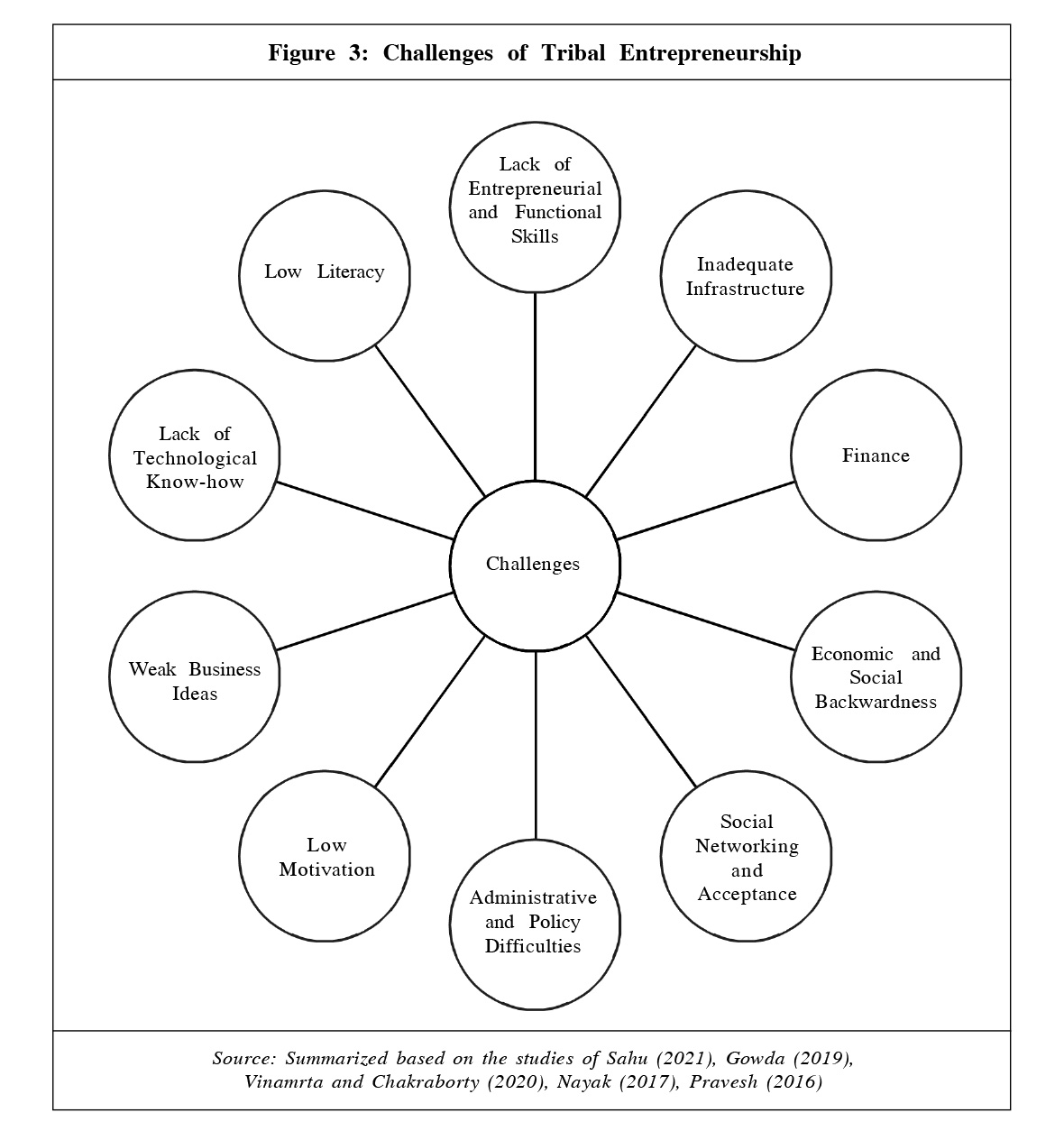
Conclusion
Tribal entrepreneurship development can lead to inclusive growth of the country. Tribals, considered as 'the man standing on the last mile', need to be brought into mainstream growth and development journey. Originally, tribals were self-reliant as their survival was on their respective 'tribal economy'. Tribal economy is sustainable as it leverages the needs of man and nature adequately. However, with the country's growth and development notion, the tribals had to fall in and mingle with the mainstream, which has created an imbalance. This calls for handholding of this section in our society. Thus, by focusing on tribal entrepreneurship, the specific business challenges can be addressed appropriately.
Existing studies reveal that opportunities do exist for the tribal entrepreneurs within their community and vicinity; they have traditional knowledge base and expertise that can be turned into business opportunity. However, what is hindering their growth and development is ignorance of the individuals, mobility, and dissemination of information about the government schemes and policies for entrepreneurship. Thus, there is a need for identifying the opportunities and challenges facing specific tribal community and regions so that accordingly they can be educated and trained.
This study is purely based on secondary source. Inference built and shared through this piece of academic work is purely based on secondary data. Research in this area has immense scope. Empirical, case-based, and comparative studies can be undertaken for gaining better insights on tribal entrepreneurship.
References
- Baporikar N (2009), Entrepreneurship Development & Project Management, Himalaya Publishing House, Mumbai.
- Gowda V R (2019), "Dalit Entrepreneurship - Opportunities and Challenges with Special Reference to Dakshina Kannada District of Karnataka, Coimbatore, Tamil Nadu", Research and Development Centre, Bharathiar University.
- Ministry of Tribal Affairs (2022), Retrieved from Ministry of Tribal Affairs: https://tribal.nic.in/ST/Statistics8518.pdf
- Nayak Y (2017), "Problems of Tribal Entrepreneurs Running Micro Enterprises in Odisha: A Case Study of Selected Tribal Units of Keonjhar and Mayurbhanj Districts", Periodic Research, Vol. 6, No. 2, pp. 25-31.
- Pravesh R (2016), "Challenges and Opportunities for Tribal Entrepreneurship Development in India: An Analytical Study", Indian Journal of Research - Paripex, Vol. 5, No. 10, pp. 637-639.
- Roy K (2021), "What is the Scope of Tribal Entrepreneurship?", February 25. Retrieved from youngisthan.in: https://www.youngisthan.in/india/what-is-the-scope-of-tribal-entrepreneurship/75647
- Sahu P P (2021), "Promoting Tribal Entrepreneurship: Towards a Holistic Strategy", Kurukshetra, October, pp. 54-58.
- Types of Entrepreneurs (2021), Retrieved from harappa.education:https://harappa.education/harappa-diaries/types-of-entrepreneurs# heading_2
- Vinamrta and Chakraborty U K (2020), "Opportunities for Tribal Entrepreneurship Development in Jharkhand to Combat Post COVID-19 Challenges", Parikalpana - KIIT Journal of Management, Vol. 16, Nos. 1&2, pp. 150-163.
- Wix Blog (2021), July 8. Retrieved from Wix.com: wix.com/blog/2021/07/types-of-entrepreneurship/
- Yojana (2022), "Tribals: Sustaining the Roots", YOJANA, Vol. 66, No. 7, p. 5.